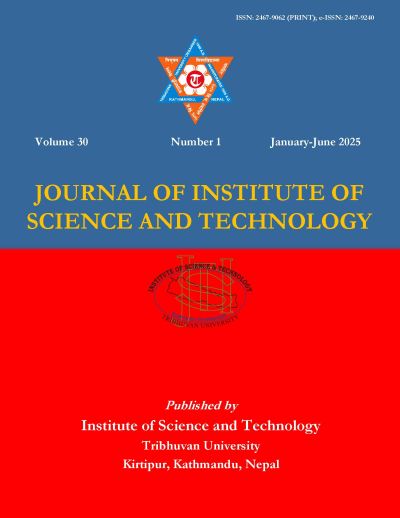Landslide Susceptibility Assessment in the Marin Khola Watershed of the Sub Himalaya, Central Nepal
DOI:
https://doi.org/10.3126/jist.v30i1.76264Keywords:
Landslide susceptibility, Marin Khola watershed, InfoVal method, SiwaliksAbstract
Nepal is facing the threat of landslides each year causing huge loss of lives and properties. Landslide prediction and susceptibility assessments help in identifying the potential zones of landslide occurrences and provide opportunities to treat them prior to their occurrence. Among different methods of landslide susceptibility mapping, the InfoVal method is one of the simple and useful methods. In this study, this method is used to study the landslide susceptibility in the Marin Khola Watershed within the Siwaliks of central Nepal as this area comprises of the weak geological formations that contribute to high potentialities of landslides, yet there are no studies for predicting landslides. A total of 217 landslides were taken for the study and they were divided into two groups: working landslides and validating landslides. 75% of these total landslides were selected as working landslides and the remaining 25% were selected for validating landslides. Spatial relationships of the landslide distribution with different causative factors including topographic factors, hydrologic factors, geological factors and landuse factors were employed and analyzed. The results depict that very high, high, moderate, low and very low susceptibility classes cover 1.15%, 49.93%, 30.17%, 11.48%, and 11.28% area, respectively. The Middle Siwaliks are most susceptible to landslides compared to the Upper Siwaliks and Lower Siwaliks. The accuracy values are found to be affected by the difference in the landslide characteristics and types occurring in the study area. The model accuracy remains at 66% and predictive accuracy at 75%.
Downloads
References
Bhandari, B.P., Dhakal, S., & Tsou, C.-Y. (2024). Assessing the prediction accuracy of frequency ratio, weight of evidence, Shannon entropy, and information value methods for landslide susceptibility in the Siwalik Hills of Nepal. Sustainability, 16(5), 2092.
Bhandari, B.P., & Dhakal, S. (2021). Decadal evolution of landslides in the Siwalik Zone: a Case Study of Babai Watershed, Nepal. Journal of Institute of Science and Technology, 26(1), 57–62. https://doi.org/10.3126/jist.v26i1.37864.
Bhandari, B.P., & Dhakal, S. (2020). Spatio-temporal dynamics of landslide in the sedimentary terrain: A case of Siwalik zone of Babai watershed, Nepal. SN Applied Sciences, 2, 854, https://doi.org/10.1007/s42452-020-2628-0.
Cevik, E., & Topal, T. (2003). GIS-based landslide susceptibility mapping for a problematic segment of the natural gas pipeline, Hendek (Turkey). Environmental Geology, 44, 949-962.
Chen, W., Li, W., Xie, X., et al. (2018). Landslide susceptibility modeling using hybrid machine learning techniques based on GIS. Sustainability, 10(5), 1452.
Cruden, D.M. (1991). A simple definition of a landslide. Bulletin of the International Association of Engineering Geology, 43, 27–29.
Dai, F.C., Lee, C.F, Li, J., & Xu, Z.W. (2001). Assessment of landslide susceptibility on the natural terrain of Lantau Island, Hongkong, Environmental Geology, 40, 381-391.
Dhakal, S. (2015). Evolution of geomorphologic hazards in Hindu Kush Himalaya, In: Shaw, R., & Nibanupudi, H.K. (Eds.), Mountain hazards and disaster risk reduction (pp. 53-72), Springer Japan, doi: 10.1007/978-4-431-55242-0_4.
Lee, S., & Pradhan, B. (2007). Landslide susceptibility mapping using frequency ratio, logistic regression, and artificial neural network models: A case study of Korea. Environmental Earth Sciences, 53(1), 117-131.
Paudyal, K.R., Devkota, K.C., Parajuli, B.P., Shakya, P., & Baskota, P. (2021). Landslide susceptibility assessment using open-source data in the Far Western Nepal Himalaya: Case studies from selected local level units. Journal of Institute of Science and Technology, 26(2), 31–42. https://doi.org/10.3126/jist.v26i2.41327.
Pradhan, A.M.S., & Kim, Y. (2016). Spatial data analysis and application of evidential belief functions to shallow landslide susceptibility mapping at Mt. Umyeon, Seoul, Korea. Bulletin of Engineering Geology and Environment, 76, 1263-1279.
Pradhan, A.M.S., Duwadi, A., & Kim, Y. (2012). Use of different statistical landslide susceptibility methods: A case study of Kulekhani watershed, Nepal. Journal of Nepal Geological Society, 44, 1-12.
Regmi, A.D., Devkota, K.C., Yoshida, K., et al. (2014). Application of statistical index and weights-of-evidence models in landslide susceptibility mapping. Arabian Journal of Geosciences, 7(2), 725-742.
Saaty, T.L. (1980). The analytical hierarchy process. McGraw-Hill, New York.
Siddle, H.J., Jones, D.B., & Payne, H.R. (1991). Development of a methodology for landslip potential mapping in the Rhondda Valley (pp. 137-142). In: Chandler, R.J. (Ed.), Slope stability engineering. Thomas Telford, London.
Terzaghi, K. (1950). Mechanism of landslides. Engineering Geology, 1, 83-123.
TU-CDES. (2016). Landslide inventory characterization and engineering design for mitigation works of Chure area in ten districts. Central Department of Environmental Science, Tribhuvan University and Government of Nepal, Chure-Tarai Madhesh Conservation Development Board, Kathmandu.
Van Westen, C.J. (1994). GIS in landslide susceptibility zonation: A review, with examples from the Andes of Colombia (pp. 135-165). In: Price, M.F., & Heywood, D.I. (Eds.), Mountain environments and geographic information systems. Taylor and Francis Publishers.
Van Westen, C.J. (1997). Statistical landslide susceptibility analysis, ILWIS 2.1 for Windows application guide. ITC Publication, Enschede: pp. 73-84.
Van Westen, C.J. (2000). The modelling of landslide hazards using GIS. Surveys in Geophysics, 21(2-3), 241-255.
Varnes, D.J. (1984). Landslide hazard zonation: a review of principles and practice. UNESCO, Paris.
Yalcin, A. (2008). GIS-based landslide susceptibility mapping using analytical hierarchy process and bivariate statistics in Ardesen (Turkey): Comparisons of results and confirmations. CATENA, 72, 1-12.
Yin, K.L., & Yan, T.Z. (1988). Statistical prediction model for slope instability of metamorphosed rocks. Proceedings of 5th International Symposium on Landslides, Lausanne, Switzerland (2), pp. 1269–1272.
Downloads
Published
How to Cite
Issue
Section
License
Copyright (c) 2025 Institute of Science and Technology, T.U.

This work is licensed under a Creative Commons Attribution-NonCommercial 4.0 International License.
The views and interpretations in this journal are those of the author(s). They are not attributable to the Institute of Science and Technology, T.U. and do not imply the expression of any opinion concerning the legal status of any country, territory, city, area of its authorities, or concerning the delimitation of its frontiers of boundaries.
The copyright of the articles is held by the Institute of Science and Technology, T.U.




